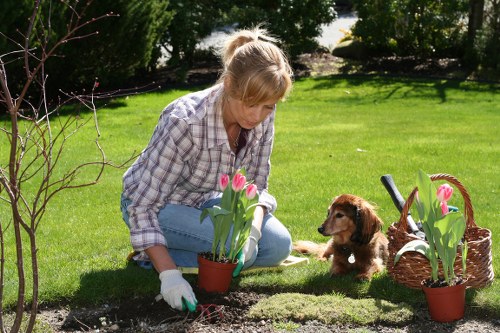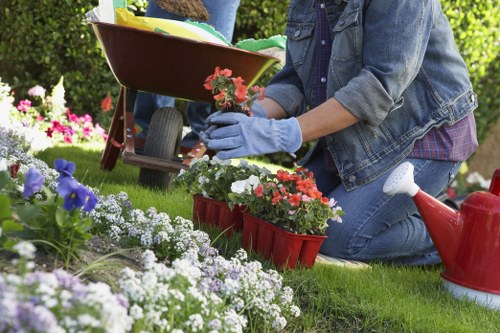Garden Fence Replacement St Albans

Replacing a garden fence in St Albans can significantly enhance the beauty, security, and value of your property. Whether your current fence is outdated, damaged, or no longer serves your needs, understanding the process and options available is essential. This guide provides comprehensive insights into garden fence replacement in St Albans, ensuring you make informed decisions that align with your aesthetic and functional requirements.
St Albans, known for its picturesque landscapes and historic charm, offers homeowners a variety of fencing options to complement their gardens. From traditional wooden fences to modern metal alternatives, the choices are vast. However, selecting the right type involves considering factors like durability, maintenance, and local regulations.
In this article, we will explore the key aspects of garden fence replacement in St Albans, including the benefits of upgrading your fence, the different materials available, the replacement process, and maintenance tips to keep your fence looking pristine for years to come.

Why Replace Your Garden Fence?
There are several compelling reasons to consider replacing your garden fence. Understanding these can help you prioritize the replacement and choose the right type of fence for your needs.
Enhanced Security
A sturdy fence acts as a barrier against intruders, providing peace of mind and ensuring the safety of your family and belongings. If your current fence is worn out or damaged, it may no longer offer the necessary protection.
Improved Aesthetics
Updating your fence can transform the look of your garden, adding value and curb appeal to your property. A well-chosen fence complements your home's architecture and enhances the overall landscape.
Privacy
For those seeking more privacy, replacing an old fence with a taller or solid-design option can create a secluded garden space, free from the view of neighbors and passersby.
Additionally, a new fence can help demarcate property boundaries clearly, preventing disputes and ensuring clarity for both you and your neighbors.
Investing in a new garden fence is not just about functionality; it's also about creating a space that reflects your personal style and meets your practical needs.

Types of Garden Fences
Choosing the right type of fence for your garden involves understanding the various materials and styles available. Here are some popular options in St Albans:
Wooden Fences
Wooden fences are a classic choice, offering versatility and natural beauty. They can be customized in terms of height, design, and finish, allowing you to match your garden's aesthetic perfectly.
Metal Fences
Metal fences, such as wrought iron or aluminum, provide durability and strength. They are often chosen for their elegant appearance and low maintenance requirements.
PVC and Vinyl Fences
PVC and vinyl fences are known for their resilience and ease of maintenance. They resist weathering, do not require painting, and are available in a variety of styles and colors.
Composite Fences
Composite fences combine wood fibers and plastic, offering a sustainable and low-maintenance alternative. They mimic the look of wood while providing enhanced durability.
Bamboo Fences
Bamboo fences are an eco-friendly option, adding a unique and natural touch to your garden. They are lightweight yet sturdy, making them easy to install and maintain.

Choosing the Right Fence for Your Garden
Selecting the ideal fence involves balancing aesthetics, functionality, and budget. Here are some key considerations to help you make the best choice:
Material Durability
Consider the climate in St Albans and choose a material that can withstand local weather conditions. For instance, metal fences are excellent for durability, while wooden fences may require regular maintenance.
Maintenance Requirements
Assess how much time and effort you're willing to invest in maintaining your fence. Options like metal and vinyl fences typically require less upkeep compared to wood.
Design and Style
Your fence should complement the architectural style of your home and the overall landscape. Whether you prefer a modern sleek look or a rustic charm, there's a fence type that can match your vision.
Budget
Determine your budget early on to narrow down your options. While some materials may have a higher upfront cost, they can offer long-term savings through durability and reduced maintenance.
Local Regulations
Be aware of any local bylaws or homeowners' association rules in St Albans that might dictate fence heights, materials, or styles. Ensuring compliance can save you from potential issues down the line.
By carefully considering these factors, you can select a garden fence that not only looks great but also serves your practical needs effectively.

The Garden Fence Replacement Process
Replacing a garden fence involves several steps, from initial assessment to final installation. Here's a breakdown of the typical process:
1. Assessment and Planning
Begin by evaluating the condition of your current fence. Identify any damage, wear, or areas that need improvement. Plan the new fence by considering the type, material, and design that best suits your needs.
2. Getting Permissions
Check with local authorities in St Albans to see if you need any permits for fence replacement. Adhering to regulations ensures a smooth installation process.
3. Selecting Materials
Choose high-quality materials that align with your budget and maintenance preferences. Whether it's wood, metal, or vinyl, ensure the material is suitable for outdoor use and offers longevity.
4. Site Preparation
Clear the area where the fence will be installed. Remove any existing debris, plants, or structures that might hinder the installation process.
5. Installation
Hire a professional fence installer or follow DIY guidelines if you have the necessary skills. Proper installation is crucial for the fence's stability and durability.
6. Finishing Touches
Once the fence is installed, add any finishing touches such as painting, staining, or adding decorative elements to enhance its appearance.
7. Regular Maintenance
Maintain your new fence by performing regular inspections and upkeep. This can prolong the fence's lifespan and keep it looking new.
Following these steps ensures a hassle-free fence replacement experience, resulting in a beautiful and functional garden enclosure.
Maintenance Tips for Your New Fence
Proper maintenance is key to ensuring your new garden fence remains in excellent condition. Here are some tips to keep in mind:
Regular Cleaning
Keep your fence clean by removing dirt, debris, and any staining agents. For wooden fences, consider washing with a mild detergent and water solution.
Inspect for Damage
Periodically check your fence for signs of damage such as cracks, rust, or broken panels. Addressing issues early can prevent more significant problems later.
Painting and Sealing
If you have a wooden fence, regular painting or staining can protect it from moisture and pests. Sealing ensures the wood remains strong and resistant to the elements.
Vegetation Control
Trim any plants or vines that grow on or near your fence. Overgrown vegetation can cause damage and obscure the fence's structure.
Protection from Wildlife
Ensure your fence is secure against wildlife that may attempt to climb or damage it. For metal fences, check for any weak points and reinforce them as needed.
By following these maintenance tips, you can extend the life of your garden fence and keep it looking attractive for years to come.
Cost Considerations for Fence Replacement
Understanding the costs involved in garden fence replacement is essential for budgeting and decision-making. Several factors influence the overall expense:
Material Costs
Different materials come with varying price points. For example, wooden fences may be less expensive upfront but require ongoing maintenance costs, whereas metal fences might have a higher initial cost but lower maintenance expenses.
Labor Expenses
The complexity of the installation affects labor costs. Custom designs or difficult terrain can increase the time and effort required, thereby raising the overall cost.
Fence Height and Length
The size of your fence directly impacts the total cost. Taller and longer fences require more materials and labor, resulting in higher expenses.
Additional Features
Incorporating features like gates, decorative elements, or advanced security measures can add to the overall cost. Decide which features are essential for your needs and budget accordingly.
Permits and Regulations
Some areas may require permits for fence replacement, which can involve additional fees. It's important to factor these costs into your budget.
Local Market Rates
Prices for materials and labor can vary based on local market rates in St Albans. Comparing quotes from multiple contractors can help you find the best value for your project.
By considering these cost factors, you can effectively budget for your garden fence replacement and choose options that align with your financial plan.
Local Considerations in St Albans
St Albans has its unique characteristics that can influence your garden fence replacement project. Here are some local factors to keep in mind:
Climate and Weather
St Albans experiences a temperate climate with moderate rainfall and occasional frost. Choosing materials that can withstand these conditions is crucial for the longevity of your fence.
Historical Preservation
Given the historic nature of St Albans, certain areas may have regulations regarding the appearance and materials of fences. It’s important to ensure your new fence complies with these guidelines to maintain the town's charm.
Local Aesthetics
Consider the architectural styles prevalent in St Albans when selecting your fence design. A fence that complements the local aesthetics enhances the overall appeal of your property.
Accessibility of Materials
Availability of certain materials might vary in St Albans. Working with local suppliers ensures you have access to quality materials without significant delays or increased costs.
Labor Availability
Hiring local contractors familiar with St Albans' specific requirements can lead to a smoother installation process and better results.
Understanding these local considerations helps you make informed decisions that ensure your garden fence replacement is both functional and harmonious with the St Albans environment.
Nearby Areas to St Albans
When considering garden fence replacement in St Albans, it's beneficial to be aware of the surrounding areas, each offering unique features and proximity to St Albans:
- Harpenden: Just a few miles north, Harpenden offers a mix of modern and traditional homes, perfect for various fencing styles.
- Welwyn Garden City: Southeast of St Albans, known for its well-planned layout and community parks, ideal for decorative fences.
- Hatfield: West of St Albans, balancing urban and rural settings, suitable for durable and stylish fence options.
- Bishop's Stortford: South, offering a blend of commerce and residential areas, where security-focused fences are in demand.
- Tring: Northwest, with its historic charm, favors traditional wooden fences that complement older properties.
- Radlett: Northeast, featuring upscale homes that often require elegant and high-quality fencing solutions.
- Rickmansworth: Southwest, known for its scenic areas, benefits from fences that enhance natural landscapes.
- Dunstable: Southeast, where practical and cost-effective fencing options are popular among homeowners.
- Welwyn South, offering a variety of garden styles that necessitate diverse fencing materials and designs.
- Stevenage: East, with its growing residential areas, has a demand for both modern and traditional fence styles.
- Harborough: Nearby smaller communities, each with unique requirements based on their specific environments.
- Knebworth: Close to St Albans, known for its stately homes and gardens, favoring ornate and high-quality fence options.
- Stotfold: North, with a mix of rural and suburban areas, suitable for various fencing styles from rustic to contemporary.
- St Margarets: Adjacent to St Albans, offering easy access to local services and fencing contractors.
- Wheathampstead: Northwest, with its village feel, prefers natural and traditional fencing materials.
Each of these nearby areas has its distinct characteristics and preferences, providing a diverse market for garden fence replacement in St Albans.
Frequently Asked Questions
1. How long does it take to replace a garden fence in St Albans?
Typically, replacing a garden fence can take anywhere from a few days to a couple of weeks, depending on the size of the fence, the materials chosen, and the complexity of the installation.
2. What is the average cost of garden fence replacement in St Albans?
The cost varies based on materials, fence length, and labor. On average, homeowners can expect to spend between £1,000 and £5,000 for a complete fence replacement.
3. Do I need a permit to replace my garden fence in St Albans?
In some cases, especially for high fences or those in conservation areas, a permit may be required. It's advisable to check with the local council before starting your project.
4. What materials are best suited for the St Albans climate?
Materials like metal, vinyl, and treated wood are well-suited for St Albans' temperate climate, offering durability and resistance to weather conditions.
5. Can I install a garden fence myself, or should I hire a professional?
While DIY installation is possible for those with the right skills and tools, hiring a professional ensures a higher quality installation and adherence to local regulations.